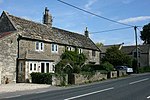Midway Manor
Midway Manor is a country house and farm in Wingfield parish about 1+1⁄2 miles (2.4 km) south of Bradford on Avon in Wiltshire, England. The house is approximately midway between Bradford on Avon and Wingfield, on the B3109 road. It was originally an Elizabethan Manor Farm flanked by two large stone barns. In about 1723, the Midway estate was the property of the Shrapnel family who were prosperous cloth merchants from Bradford on Avon. Lieutenant-General Henry Shrapnel (3 June 1761 – 13 March 1842), inventor of the Shrapnel shell, was born at Midway Manor which remained with the Shrapnel family until 1871.The house had stone cannonballs mounted in various places on the front façade and a carving of the Shrapnel shell exploding with the Latin inscription Ratio Ultima Regum ("the Last Argument of Kings"), a phrase Louis XIV of France had cast on the cannons of his armies. This carving is now immediately outside the Manor's entrance gates. On the back of the gate piers, the names of some of the battles that were won with the aid of the Shrapnel shell are engraved. On top of each are four of the original spherical case shots. The late-19th century gate piers are Grade II listed since 1988.In 1892, the Manor became the property of Henry Baynton who removed the front façade, necessitating an almost complete rebuilding of the house with stone provided from the barns which were then demolished. The main structure of the house became very much as it is today.
Excerpt from the Wikipedia article Midway Manor (License: CC BY-SA 3.0, Authors).Midway Manor
Geographical coordinates (GPS) Address Nearby Places Show on map
Geographical coordinates (GPS)
| Latitude | Longitude |
|---|---|
| N 51.326 ° | E -2.2607 ° |
Address
BA15 2AJ , Wingfield
England, United Kingdom
Open on Google Maps









